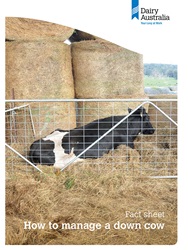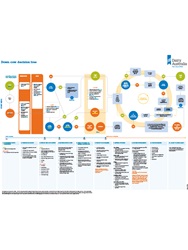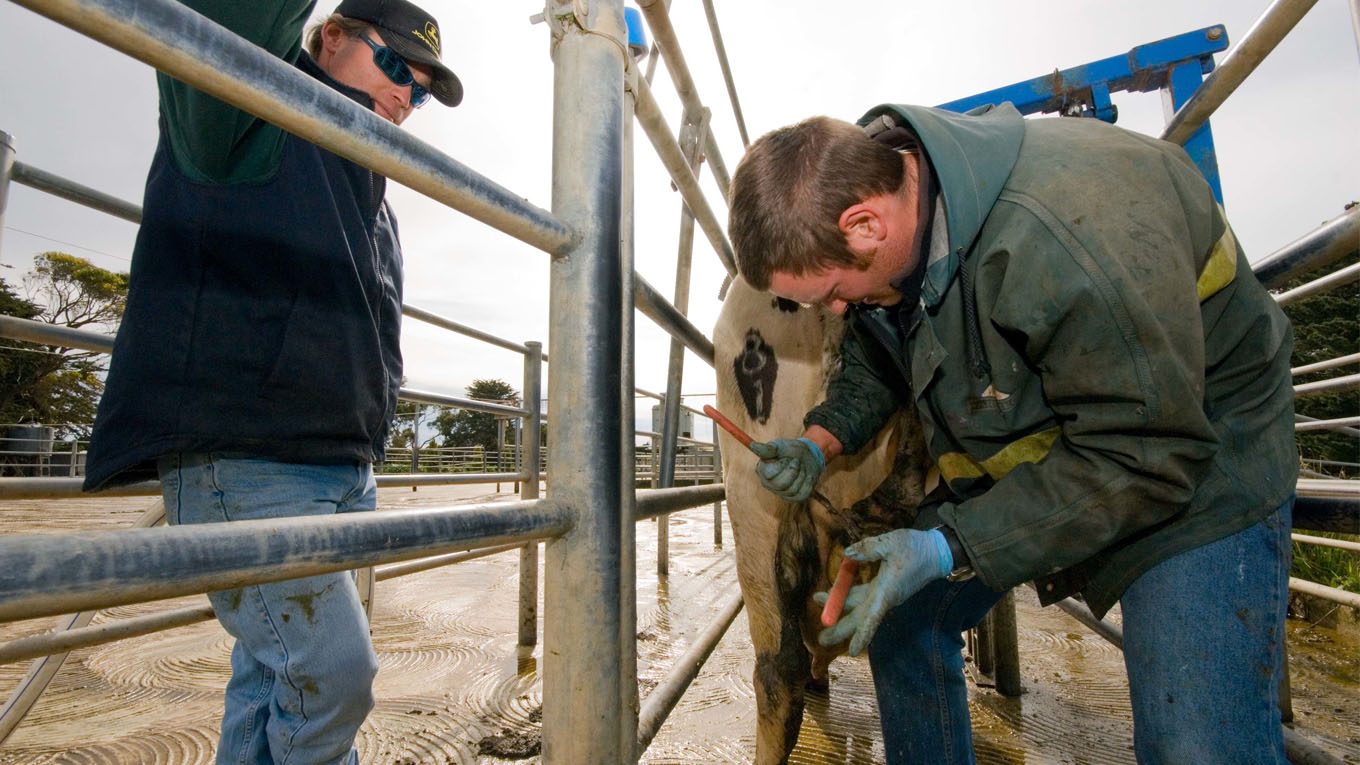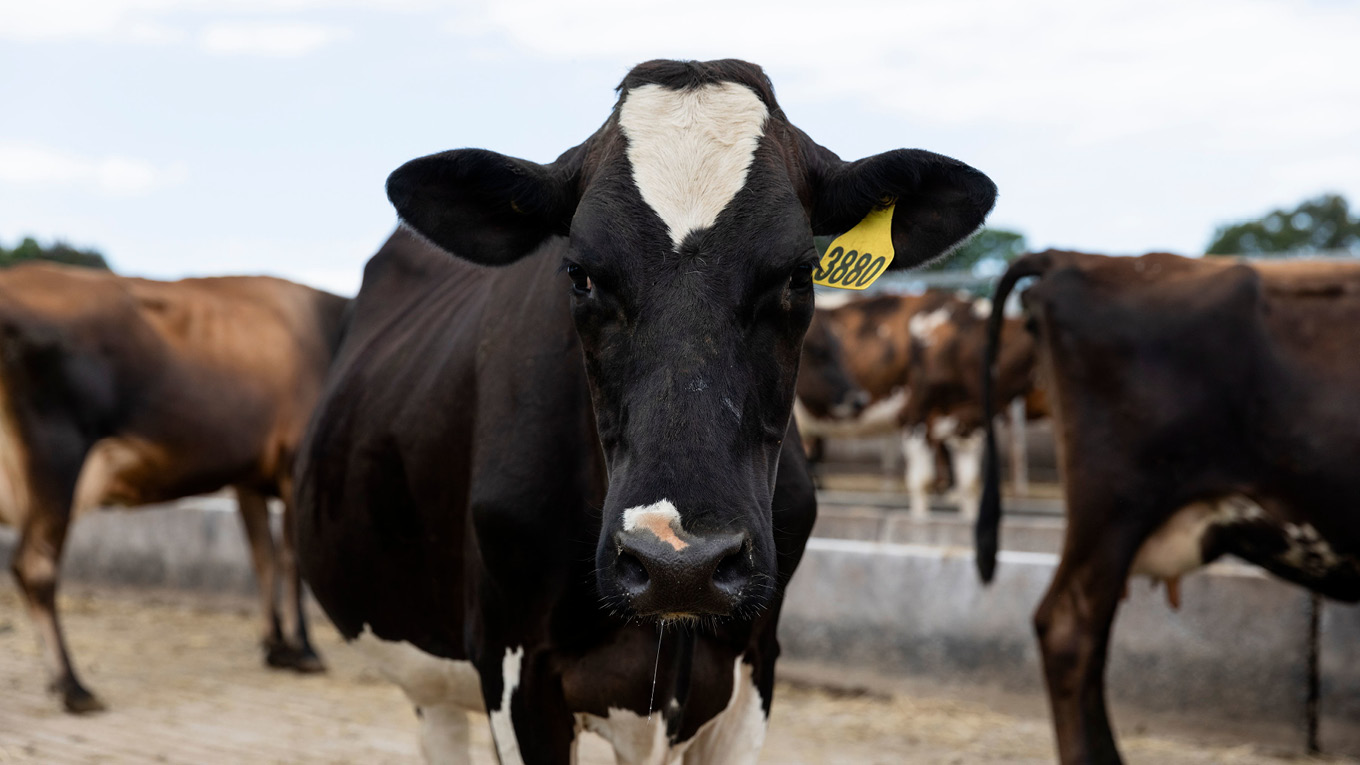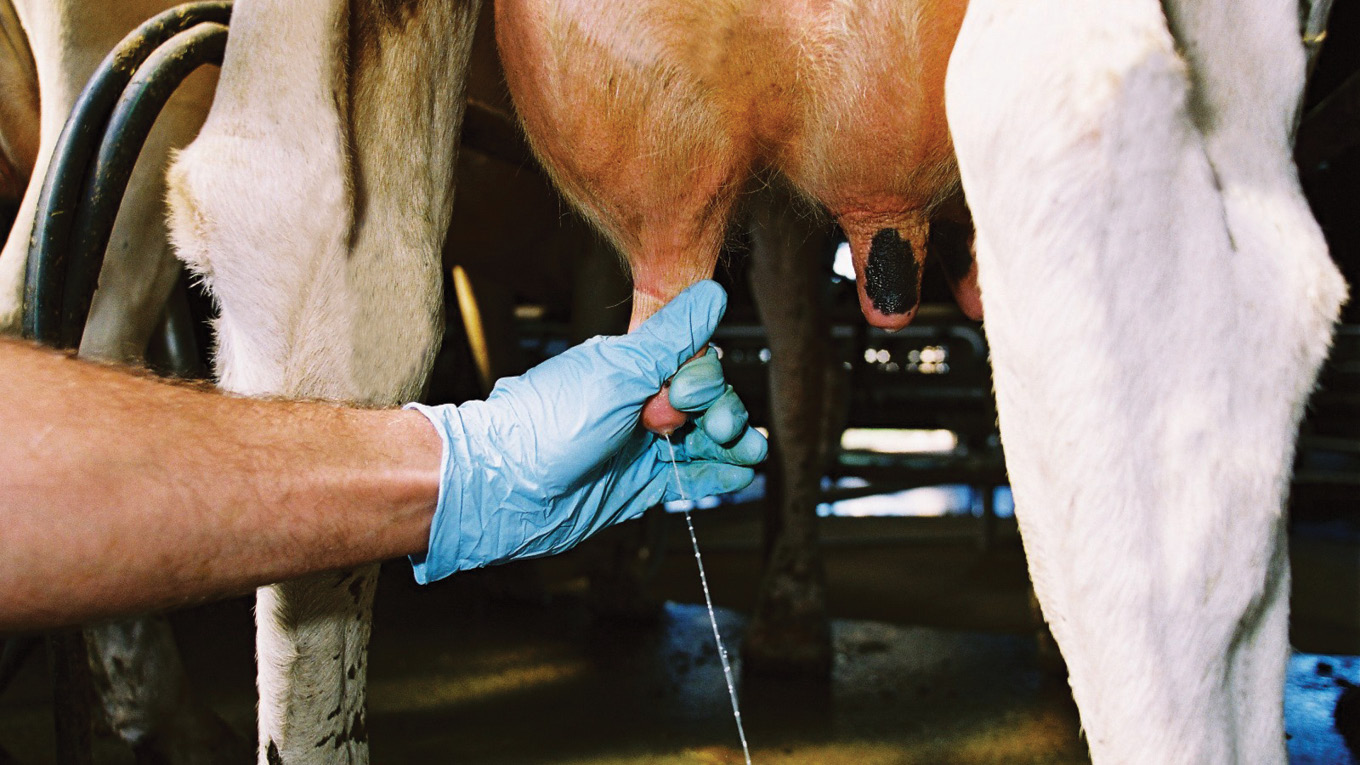Down Cows
A 'down cow' is a cow that is unable to stand unassisted, even if she is able to walk once she has been assisted to her feet. Cows may be down either due to primary reasons or secondary reasons.
Some primary reasons for cows to go down include metabolic disease (such as milk fever, ketosis or grass tetany), severe infection (such as black mastitis) or injuries (such as calving paralysis or a dislocated hip). Once a cow is down, they are very susceptible to secondary pressure damage, especially to the nerves and muscles of the legs. This damage can occur within a few hours, especially if they are on a hard surface like concrete or gravel, or if they are a large-framed, heavy cow.
Secondary damage can often be more important in a cow's chance of recovery than the primary cause of her going down. Many down cows have a combination of both primary and secondary conditions making up their syndrome.
"Downer cows" are cows that are bright and well in themselves (indicating they may have recovered from their primary cause) but they are still unable to stand unassisted after a day.
Managing down cows
Down cows must be immediately assessed to decide how critical the cow's condition is.
A cow with abnormal behaviour (dull or depressed or a very agitated or aggressive down cow) is an emergency and needs to be attended to immediately.
Bright and alert cows can be attended as soon as possible, unless they are in an unsafe environment. This may include a cow that is lying on her side, on a hard surface, exposed to adverse weather conditions or in a situation where she could do damage to herself or to people.
Down cows need to be treated appropriately and quickly to maximise their chance of recovery. This requires an accurate diagnosis of the primary cause and prevention and treatment of secondary damage, if present. It is critical dairy farmers call their vet if they are unsure or if the cow is not responding to treatment.
Australian research has demonstrated that the quality of down cow nursing is highly correlated to the chance of secondary damage occurring and to her final outcome, so high-quality nursing must be started immediately when a cow goes down.
When moving a down cow, such as to the nursing area, care must be taken to not cause any further damage or distress to the cow.
Euthanasia
The welfare aspects of the down cow must always be carefully considered. Any downer cow that has a poor chance of recovery, is suffering unduly or that cannot be nursed to a high standard must be humanely euthanased.
Treatment of the down cow
The initial required treatment will depend on the primary condition. It may include antibiotics, metabolic solutions and anti-inflammatory drugs. Anti-inflammatory drugs may also be required to help treat or prevent secondary muscle and nerve damage. Antibiotics and anti-inflammatory drugs are only available under prescription from vets.
If the cow is recumbent with a condition where she is unlikely to recover on the same day, she should be moved to a suitable nursing area. The sooner this is done, the less chance there is of secondary damage occurring.
Nursing the down cow
Nursing of a down cow should only be undertaken if the cow has a reasonable chance of recovery and competent stock people are on hand.
High-quality nursing can be labour intensive and time consuming. It is best done in a dedicated nursing area that is set up with the following:
- Good quality feed and water
- Adequate soft, deep bedding
- Barriers to confine the cow in the area and to prevent her from crawling
- Suitable shelter from the elements (both excess heat and cold)
- Conveniently located so the cow can be monitored regularly.
Lifting a down cow is beneficial if it is done correctly and appropriately. However, it can be very harmful to the cow if not done appropriately.
Cows should only be lifted if they are lifted effectively and under supervision. Effective lifting means the cow is taking at least most of her own weight. Lifting must be supervised so the cow can be lowered as soon as she tires and needs to sit down again.
Some cows will stand effectively for several hours but others for only a few minutes.
Contrary to common belief, leaving a cow hanging from a lifting device does not improve circulation and is unacceptable. Some cows resent being lifted so will not cooperate. These cows should not be lifted and continuing to try is counter-productive.
Some down cows may be able to roll from side to side by themselves whereas others only sit on one side. If they are unable to swap sides by themselves, the cow needs to be rolled several times a day, ideally every 3–4 hours. Rolling the cow regularly will reduce the chance of secondary damage to the hind limbs.
Down cows must be closely monitored and if they are found to be lying on their side they must be sat up immediately. A cow lying on her side is at risk of dying from bloat or breathing in her rumen contents, or suffering pressure damage to her front legs.
Farmers requiring specific advice on the management of a down cow should contact their vet.
This short video demonstrates how to care for a down cow with some basic nursing rules.
Information tools for managing down cows
Decision tree for down cows
Videos
These short videos can assist with the different aspects of down cow management and welfare.
Moving
This video shows a safe and easy way to move a down cow using a front-end loader bucket
Rolling
This video shows the easy way to roll a down cow
Lifting
There are a number of different devices for lifting down cows and they should only be used if appropriate
Lifting the down cow
This video shows how to use a hip clamp with the cow standing "effectively"
Hip clamp
This video shows how to use a hip clamp but the cow is unable to stand "effectively" after being lifted
Pelvic lifter
This video shows how to use a pelvic lifter but the cow is unable to stand "effectively" after being lifted
Upsi-daisy cow lifter
This video shows how to use an Upsi-daisy cow lifter but the cow is unable to stand "effectively" after being lifted
The nursing area
This video shows how to set up a "dedicated nursing area" for down cows, which every dairy farm should have available to use when needed
Caring
This video shows the basic care requirements of down cows
Assessing
This video has some general information on what to look for when a down cow is found to help guide the assessment and management of her
For more information on the methods around getting a down cow on her feet, visit Dairy Australia's Animal Welfare page.
Down cow syndromes
The following information describes some of the more common causes of down cows to help understand their causes, risks and treatment. There are many other causes. Those unsure should seek veterinary advice.
Milk fever
What to look for
- Depressed/dull, down cow shortly before or after calving
- Often found lying down, sitting upright with the head bent around to the side
- As the disease progresses cows will roll onto their side
- If not treated promptly, cows will become unconscious and die within a few hours
- In early stages cows may be shaky and appear unstable when standing and walking
Cause
Milk fever is caused by low blood calcium level. Around calving time, cows need to mobilise large amounts of calcium from body stores, such as bone, to cope with the large losses into the milk. If this occurs too slowly, the amount of calcium in the blood may fall below optimal levels resulting in milk fever.
Animals likely to be affected
Older, high-producing cows in good body condition, shortly before or after calving are likely to be affected by milk fever. Milk fever occasionally occurs a few weeks after calving when cows are in oestrus. Jerseys are more commonly affected than other breeds.
Confirming the diagnosis
Milk fever is usually diagnosed by the cow's history and her response to treatment. If the cow is found dead, laboratory testing can help rule out other possible causes of sudden death.
Treatment
Cows with milk fever need immediate treatment with injections of calcium solution. Calcium pouches may contain straight calcium borogluconate solution or calcium combined with magnesium, phosphorous and glucose (4 in 1).
The calcium pouches can be given under the skin and take half an hour to two hours to be absorbed. More rapid responses can be achieved by intravenous administration but this must be done carefully as calcium given too quickly or excessively will cause a heart attack and kill the cow. Intravenous administration is best performed by a vet. Occasionally, injections given under the skin can cause problems such as swelling and infection.
Cows need to be watched after treatment because they can recover and then have a relapse in the following days. If a cow responds to treatment but is still unable to get to her feet, she should be encouraged to rise, and/or appropriately lifted with a lifting device, as lying down for a number of hours can lead to further complications.
Risk factors
- Cows calving in good or fat condition
- Older cows and jerseys
- Inadequate transition cow management
Prevention
Improving transition feeding during the three weeks before calving is the single most effective way of preventing milk fever. More information on transition cow feeding can be found on the transition cow management page.
Grass tetany
What to look for
Grass tetany can range from mild signs to a rapidly fatal illness.
- Sudden death
- Strange behaviour or aggression
- Convulsions and muscle spasms
- Over reaction to sounds or movement
- Collapse and "paddling"
Cause
Grass tetany is caused by low magnesium intake. Cattle cannot store magnesium so they require a daily intake to maintain adequate blood levels. Grass tetany occurs when the cow's magnesium levels drop below a threshold level. Animals are most at risk when grazing lush pasture, especially if it has been fertilised with nitrogen or potash. Outbreaks of grass tetany may be set off by a sudden change of pasture or by bad weather that reduces grazing time.
Animals likely to be affected
Dairy cattle within the first three months after calving are most likely to be affected by grass tetany. Susceptibility increases with age. Grass tetany can affect multiple animals.
Confirming the diagnosis
Grass tetany may be diagnosed by the cow's history, symptoms and a blood test. Blood magnesium levels are not a reliable diagnostic test in dead animals, so a vet may take a fluid sample from the back chamber of the eye.
Treatment
The aim of grass tetany treatment is to increase blood levels of magnesium as quickly as possible. Magnesium (Mg) sulphate pouches (typically containing approximately 25% Mg) and/or 4 in 1 pouches (containing approximately 5% Mg, calcium, phosphorus and glucose) can be safely given under the skin. Intravenous administration of 4 in 1 will give a faster response but must be done carefully to avoid killing the cow from excess calcium. Intravenous administration is difficult in an animal with convulsions and is best done by a vet. Solutions containing 25% magnesium must not be given intravenously as it will cause a heart attack and kill the cow. A quiet environment will help the animal recover better after treatment.
Risk factors
- Grazing on lush pasture, especially if it has been fertilised with nitrogen or potash
- Cows in early lactation
- Bad weather or sudden change in pasture
Prevention
Adequate transition cow management can prevent grass tetany. Supplementing the cows' diet with magnesium compounds are also effective but require daily administration. This can be done by adding magnesium to feed in the bail, spraying it on to hay, adding it to water or using magnesium blocks.
Pregnancy toxaemia
What to look for
Cows in late pregnancy, usually within 2–3 weeks of calving may become depressed, stop eating and lose weight. They may also be found down. If not successfully treated, they will eventually die.
Cause
Pregnancy toxaemia occurs in cows in late pregnancy which are not receiving adequate levels of energy and protein.
Animals likely to be affected
Cows in the last month of pregnancy that are not receiving adequate levels of energy or protein are likely to be affected by pregnancy toxaemia.
Other diseases with similar signs
Pregnancy toxaemia is one of a number of metabolic diseases that result from nutritional stress and disruption of the cow's energy metabolism. Fat cow syndrome and ketosis have similarities to pregnancy toxaemia.
Confirming the diagnosis
Some cows with pregnancy toxaemia have a strong smell of ketones (like acetone-based nail polish remover) on their breath. Laboratory tests can confirm the diagnosis and provide information on such things as liver function and the level of ketosis.
Treatment
Once a cow has gone down due to pregnancy toxaemia her prognosis is poor. Treatment requires a re-balancing of the cow's energy situation by increasing the energy intake in and decreasing the demands for energy.
High-quality feed needs to be provided to the cow, including drenching with propylene glycol (sometimes called "pink drench") twice daily.
Injecting a pouch of glucose solution into the vein or under the skin only provides very short-term energy.
Most veterinarians will induce the cow to calve prematurely to remove the energy drain on the cow.
Lifting the cow to her feet will improve the chance of success because if the cow is able to stand she will walk around and graze.
Risk factors
- Cows in late pregnancy that are in very good/fat condition
- Cows in late pregnancy that are in poor condition
- Cows carrying twins
- Inadequate energy or protein intake
- Inclement weather
Prevention
The nutrition of dry cows should be reviewed if pregnancy toxaemia cases occur.
Toxic mastitis
What to look for
Toxic mastitis is a very serious form of mastitis that presents with severe, sudden illness with the affected cow often initially found down. The cow will be depressed, sunken eyed from dehydration and often has a red/brown watery secretion in the udder rather than milk. The teat and/or wall of the udder will become cold and clammy from gangrene. The entire affected quarter can slough off over the ensuing weeks, leaving a three-quartered udder.
Cause
Toxic mastitis is caused by an overwhelming infection with bacteria, such as E.coli or Staph aureus, often in a cow whose immune system has been compromised.
Animals likely to be affected
- Usually occurs in or around calving
- Can occur in the days following drying off
Confirming the diagnosis
Toxic mastitis can be confirmed by observation of abnormal, watery milk with a cold or swollen quarter in a very sick cow.
Treatment
Cases of toxic mastitis need rapid treatment and are a veterinary emergency. Intravenous fluids may need to be given along with high levels of appropriate antibiotics. Anti-inflammatory drugs are often used to help counter the toxic shock.
Risk factors
- Leaking milk prior to calving
- Muddy or heavily soiled calving environment
- Poor hygiene practices when administering dry cow antibiotics or teat sealants at drying off time
Prevention
- Use of teat sealants at drying off
- Ensuring cows are able to calve in a clean, dry environment
- Excellent hygiene practices when administering dry cow antibiotics or teat sealants
Calving paralysis
What to look for
- Bright and alert cow down from the time of calving
- Found lying down often with a calf stuck in the birth canal or a dead calf behind her if she has delivered it
- Usually swollen around the vulva indicating trauma
- Unable to stand because of the paralysis
- Some cows with milder damage will be able to stand but walk with a "dead" hind leg
Cause
Calving paralysis is caused by damage to the nerves of the hind limbs from an over-sized calf compressing the nerves within the pelvis during an obstructed calving.
Animals likely to be affected
- Smaller, poorly-grown heifers are most at risk
- Some bulls throw very large calves and, if so, any cow pregnant to these bulls can be at risk
- Any cow experiencing a prolonged calving without assistance is more likely to be affected
Other diseases with similar signs
Other conditions around calving when the cow presents down with an alert mental state have similar signs to calving paralysis, such as back injury, hip dislocation and pregnancy toxaemia.
Confirming the diagnosis
Lifting the cow will often show that she doesn't have normal control of her hind limbs. The affected leg will often not respond to sensation when stimulated.
Treatment
Anti-inflammatory injections administered as soon as possible following a difficult calving are shown to help with calving paralysis. These are only available on prescription from vets.
Damage from calving paralysis can range from very mild to total paralysis so some cows will recover quickly but others never will. High-quality nursing is required to give the cow a chance of recovery. Severely affected cows or those that cannot be nursed at a high level should be humanely euthanased.
Risk factors
- Small, poorly grown heifers
- Inappropriately selected sires
- Inadequately supervised calving cows
Prevention
Ensuring heifers are adequately grown at joining time and continue to be well-fed afterwards ensures well-grown heifers at the time of calving, thus reducing the risk of calving paralysis. The bulls used to join the heifers and cows must be of a suitable breed and throw appropriately sized calves. "Calving ease" is one trait listed for AI sires and should be used to help guide sire selection.
Secondary causes of down cows
Sciatic nerve damage
The sciatic nerve passes around the hip through the hamstring muscle and crosses over the outside of the stifle to the hoof. It controls some of the hip muscles, the hamstrings and all of the muscles and tendons below the stifle. It is prone to pressure damage if a cow is lying on a hard surface at a number of places along its course and is a common form of secondary damage.
Such damage to the sciatic nerve may prevent the cow from rising after she has recovered from her primary condition (such as milk fever) although some cows will be able to walk but show abnormal posture and gait. These abnormalities will show when the down cow is lifted and include:
- The hoof knuckling over so the cow stands on the top of her hoof
- The hind limb tends to go forward and towards the cow's other hind leg as she is unable to bring her leg backwards and outwards
Secondary sciatic nerve damage is a sign of poor-quality nursing and often occurs when a cow is lying on a hard surface and she cannot/is not rolled frequently from sitting on one leg to the other. Larger, heavier cows are more at risk.
Treatment involves improving the nursing, especially by providing deep, soft bedding and regularly rolling the cow. Anti-inflammatory drugs will help.
Femoral nerve
The femoral nerve leaves the spinal cord in the lower back and supplies the quadriceps muscle, which is the muscle that mainly allows a cow to stand up. Cows that crawl around tend to get their hind legs out behind them (frog-leg position), which can cause damage to the femoral nerve by over stretching. This is a common condition in down cows, especially in cows with milk fever which do not stand soon after treatment and crawl whilst trying to stand.
Treatment involves good-quality nursing where the cow is prevented from crawling and from falling if they can stand after being lifted. Anti-inflammatory drugs will help.
Forelimb nerves
The nerves of the forelimb pass between the ribs and the shoulder blade and can be compressed between these two bony structures if the cow lies on her side, especially if the ground is hard. Some affected cows will be able to stand but walk dragging their knuckled over hoof. However, often these cows will not be able to stand.
If the cow is lifted and all of the nerves are damaged, the entire front leg will hang limply. However, if it is only the nerve supplying the lower limb that is damaged, only the hoof will be knuckled over. Most cows with forelimb nerve damage will not try to stand when lifted to their feet and this is often confused with thinking that the cow is sulking.
Treatment involves high-quality nursing over a number of days to allow the damaged nerves to recover. Anti-inflammatory drugs will help.
If the cow is unable to maintain her normal sitting position and continually lies on one side, she should be euthanased.
Muscle damage
The hamstring muscles can be damaged from pressure if the cow lies on a hard surface for too long. This is a common secondary injury of any down cow, which is why they must be nursed on soft, deep bedding. The damage can occur within as short a time as only 1–2 hours, especially if down on concrete. It can occur following milk fever if the cow does not get back on her feet during the day that she was affected.
Any bright and alert cow that is down for more than half a day and unable to stand unassisted should be lifted onto her feet, if possible after this time period. If they are unable to stand they should be moved to a suitable nursing area with soft, deep bedding. This will decrease the risk of secondary muscle and nerve damage from occurring.
Hip dislocation
Hip dislocation is a fairly common secondary condition in down cows. It usually occurs when the cow is trying to rise to her feet but is still unsteady from her primary condition, such as milk fever or calving paralysis. The affected hind limb is in an unusual position out to the side and the cow is unable to bear weight on the leg if she is lifted. Prompt veterinary attention is required to have a chance of a successful result. However, if it is secondary to calving paralysis, it is most likely the hip will not stay in place due to the weakness from the primary damage to the nerves.
Coldness
Coldness is not an uncommon secondary complication for cows that are down for any reason under cold conditions. A cold cow will divert her blood away from her limbs to preserve her core temperature and this can cause numbness and prevent her from rising. Any cow that is down for a few hours or more under cold conditions should be moved to a warm nursing environment.
Applying a coat over the cow will also help warm her if she is cold. This is especially important if it is not possible to move her to a warm shed and she continues to be exposed to the cold elements outside in the paddock. There are a number of commercially available coats for cows, which range in price according to their quality and warming effectiveness. Coats made from hessian are cheap but basic, those made from canvas are intermediate in price and quality whilst those with heat reflective properties, similar to space blankets, are the top of the range and have best results. Horse rugs do not fit particularly well on cows but will still help in the absence of a proper cow coat.
